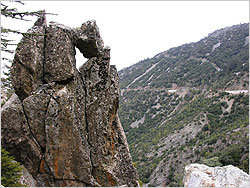|
Geology
Troodos' Geological Treasure
The Troodos mountain range is an ophiolite, a term used to describe a group of igneous rocks which make up the oceanic crust. Troodos is part of a very ancient section of oceanic crust which was uplifted to its present position due to the collision of the African and Eurasian Tectonic Plates and the subduction of the former beneath the latter. It is considered the most complete and best-studied ophiolite in the world.
On Troodos one finds all the groups of ophiolite rocks, consisting of the following stratigraphic units, in ascending order:
(a) Mantle sequence and cumulates
(b) Plutonic rocks
(c) Intrusives
(d) Volcanics and pillow lava flows
(e) Chemical sediments such as umber
 The Troodos ophiolite is oval-shaped, its longer axis having a NW-SE orientation. The mountain range is dome-shaped with Mount Olympus as its highest point (1,952m). Although stratigraphically, the ultramafic plutonic rocks are the lowest, topographically they are found at the highest point of the mountain range with progressive outcroppings by the overlying layers, forming an annular shape, the result of the intense erosion that followed the uplifting of Troodos above sea level, with Mount Olympus at its epicentre. The Troodos ophiolite is oval-shaped, its longer axis having a NW-SE orientation. The mountain range is dome-shaped with Mount Olympus as its highest point (1,952m). Although stratigraphically, the ultramafic plutonic rocks are the lowest, topographically they are found at the highest point of the mountain range with progressive outcroppings by the overlying layers, forming an annular shape, the result of the intense erosion that followed the uplifting of Troodos above sea level, with Mount Olympus at its epicentre.
A magnet to researchers from all over the world
Due to its global uniqueness, Troodos acts as an incomparable magnet for the many foreign universities that visit it regularly for the purposes of scientific research and education. Throughout the entire area of the Geopark there are superb examples of all the ophiolite rocks where researchers and students can examine, study and observe all the geological processes that have occurred and are still occurring in the depths of the oceans and are directly linked to the movement of the tectonic plates.
Let’s… rock!
On the highest parts of Mount Olympus there are plutonic rocks which were created at a great depth within the crust and, due to the slow cooling of the magma, formed large crystals. They vary from ultramafic rocks, which consist almost exclusively of dark minerals such as olivine and pyroxene, to gabbro where light- and dark-coloured minerals are in more or less equal proportion.
Of the ultramafic rocks, harzburgite is considered a residual of the partial melting of the Earth’s upper mantle, while dunite and wehrlite are the heavy products of this melting and this is precisely why they are found above the harzburgite. Gabbro, on the other hand, is a residual of magma, the composition of which was such that, upon crystallisation, increasing amounts of light-coloured minerals such as the plagioclase series appear. During the slow cooling, the heaviest minerals lie in the depths, thereby creating the darker coloured gabbro, with light-coloured varieties in the higher layers. At higher levels and in small pockets, the products of this different crystallisation are to be found, known as plagiogranites or granofires. The consist mainly of light-coloured minerals such as epidote, quartz and the plagioclase series.
Above the gabbro is a succession of usually parallel seams, created by the mutual outward movement of the tectonic plates. A typical example of this natural substrate opening-expansion may be observed today in Iceland which is split by the movements of the divergent North American and Eurasian plates. In the case of Troodos, however, the Sheeted Dyke Complex - Diabase appears in virtually the whole of the mountain range, forming an oval shape which contains the plutonic rocks of Mount Olympus and is itself contained by the extrusive volcanic rocks.
Above the Sheeted Dyke Complex are the volcanic rocks of Troodos, consisting of pillow lavas and lava flows. The characteristic spherical to ellipsoidal pillow shapes are a result of water pressure during the submarine volcanic activity and their spreading, while the pillow lavas can be 30-70cm in diameter. The crust is glassy, due to the speed of cooling and the inside is honeycombed, because of the spaces formed by the sudden expression of gases contained in the incandescent lava (>1000° C).
Above the ophiolite rocks and the pillow lavas in particular, we find the first dark/brownish sediments, several metres thick and spreading horizontally for tens of metres, known as umbers. These sediments are rich in iron oxide and manganese and are similar to the iron-rich sediments found on the sides of the mid-ocean ridges in today’s oceans. Their creation is due to warm undersea fluids, rich in iron and manganese, that were laid down on the sea-bed.
Finally, for the record, it should be noted that there is a direct link between the Troodos Ophiolite and the deposits of sulphides, chromite and asbestos, which were formed in various stratigraphic units of the Ophiolite (lavas, dunite and serpentinite respectively) and rose to the surface as a result of its uplifting.
|